Help diagnose my ADD
#1
Registered User
Thread Starter
Join Date: Nov 2006
Location: Charlotte, NC
Posts: 101
Likes: 0
Received 0 Likes
on
0 Posts
Help diagnose my ADD
ibobviousADDjoke
My 4WD quit working awhile ago and I hadn't given it much thought until recently. Here's what I can tell you:
-When I bought the truck, the 4WD worked...intermittently. When it did work the 4WD light on the dash would light up. It no longer does that.
-When I shift into 4WD (hi or low), I can hear and feel the transfer case engaging the the front drive shaft.
I think I've narrowed it down to the 4WD solenoids, the air lines leading to the ADD mechanism, or the ADD mechanism itself.
I know your supposed to test the air lines by pumping air into them and seeing if the ADD engages. But I don't know how I can do this.
Is there a way I can test the solenoids to see if those are borked?
thanks!
My 4WD quit working awhile ago and I hadn't given it much thought until recently. Here's what I can tell you:
-When I bought the truck, the 4WD worked...intermittently. When it did work the 4WD light on the dash would light up. It no longer does that.
-When I shift into 4WD (hi or low), I can hear and feel the transfer case engaging the the front drive shaft.
I think I've narrowed it down to the 4WD solenoids, the air lines leading to the ADD mechanism, or the ADD mechanism itself.
I know your supposed to test the air lines by pumping air into them and seeing if the ADD engages. But I don't know how I can do this.
Is there a way I can test the solenoids to see if those are borked?
thanks!
#2
Registered User
#3
Registered User
Join Date: Aug 2006
Location: Newfoundland, Canada
Posts: 50
Likes: 0
Received 0 Likes
on
0 Posts
Thats a great link tha RobD posted, i used the same one to help t shoot my ADD issues. I have a quick question for you. When you move your Tcase shifter from 2wd to 4wd High do you hear a solenoid click from behind the dash?? If not we have narrowed down the problem. There is a ball switch that is activated by the tcase lever and sends signal to the ADD relay behind the dash. This ADD relay then activates the VSV switches under the hood. My problem was bad wiring from the ball switch in the ADD relay. The best place to start is to remove the ball switch from the Tcase on the passengers side. It's round has two wires coming out of it and may look like it has a black cap on it. If you put our had in close the Tcase you will feel that it had six sides so you can get a wrench on it and unscrew it. Just use an Ohm meter to verify that when the ball is moved in it closes the circuit. Then start tracing the wiring to make sure there are no bad joins or broken wires. If you need a pick of the switch location let me know and I will go snap one and put it up for you.. Good luck and keep us posted!

#4
Registered User
Thread Starter
Join Date: Nov 2006
Location: Charlotte, NC
Posts: 101
Likes: 0
Received 0 Likes
on
0 Posts
Thats a great link tha RobD posted, i used the same one to help t shoot my ADD issues. I have a quick question for you. When you move your Tcase shifter from 2wd to 4wd High do you hear a solenoid click from behind the dash?? If not we have narrowed down the problem. There is a ball switch that is activated by the tcase lever and sends signal to the ADD relay behind the dash. This ADD relay then activates the VSV switches under the hood. My problem was bad wiring from the ball switch in the ADD relay. The best place to start is to remove the ball switch from the Tcase on the passengers side. It's round has two wires coming out of it and may look like it has a black cap on it. If you put our had in close the Tcase you will feel that it had six sides so you can get a wrench on it and unscrew it. Just use an Ohm meter to verify that when the ball is moved in it closes the circuit. Then start tracing the wiring to make sure there are no bad joins or broken wires. If you need a pick of the switch location let me know and I will go snap one and put it up for you.. Good luck and keep us posted!

If you don't mind, could you snap a picture of the ball switch.
Thanks!
#5
Registered User
Another option: get some Aisin or Warn hubs, remove and replace your front hubs with said Aisin or Warn hubs, then do the bypass on the ADD actuator as prescribed in the link.
So, you have to get out and twist your hubs. Beats troubleshooting!
So, you have to get out and twist your hubs. Beats troubleshooting!
#6
Contributing Member
iTrader: (3)
You can test a VSV (vacuum switching valve) by checking for vacuum at the inlet and outlet port when it should be on. Likewise, you can bypass the VSV by manually running the vacuum from the inlet to the outlet. You can also check the VSV coil for continuity with an ohm meter or test light. Common problem is the vacuum lines to the two VSVs get swapped while doing engine work.
#7
Registered User
Thread Starter
Join Date: Nov 2006
Location: Charlotte, NC
Posts: 101
Likes: 0
Received 0 Likes
on
0 Posts
You can test a VSV (vacuum switching valve) by checking for vacuum at the inlet and outlet port when it should be on. Likewise, you can bypass the VSV by manually running the vacuum from the inlet to the outlet. You can also check the VSV coil for continuity with an ohm meter or test light. Common problem is the vacuum lines to the two VSVs get swapped while doing engine work.
Second: Which setting on my DMM is ohms (resistance?) and where on the VSV would I test that?
The engines hasn't been rebuilt (yet)...so, the lines are probably connected correctly.
Trending Topics
#8
Contributing Member
iTrader: (3)
You can still shift on the fly with manual hubs. That is if you have your hubs locked, you can shift ina nd out of 4WD all you want. Of course if the hubs are unlocked, you can't shift on the fly but that would be pointless anyway.
Don't have any pix of the ADD VSVs, but here is a typical one:
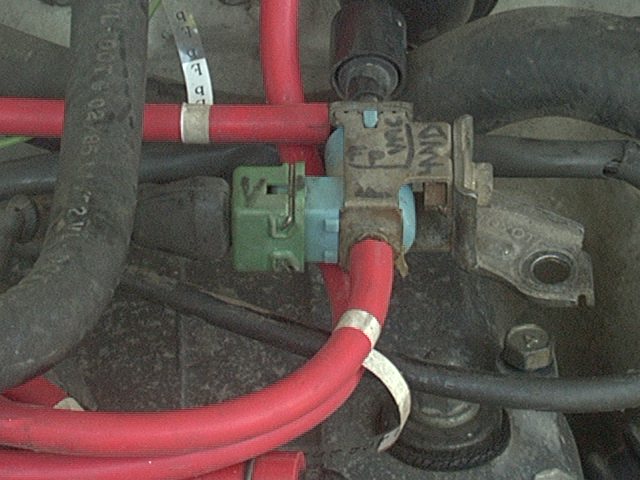
Inlet port is the one that hooks up to the engine intake (this line should have vacuum at all times). outlet port is the one that runs down to the ADD actuator. The coil is the thing with the two wires plugged into it. And yes, ohms = resistance. How to test? Pull plug, shove meter probes into connector on VSV and check for some low resistance, something around 100 ohms or so. If it reads infinite, that means the coil in the VSV is burned out.
http://www.4crawler.com/4x4/CheapTri...oUseAnOhmMeter
And don't assume the vacuum lines are connected properly. Simple check is to just swap the two ADD vacuum lines and see if it works.
Don't have any pix of the ADD VSVs, but here is a typical one:

Inlet port is the one that hooks up to the engine intake (this line should have vacuum at all times). outlet port is the one that runs down to the ADD actuator. The coil is the thing with the two wires plugged into it. And yes, ohms = resistance. How to test? Pull plug, shove meter probes into connector on VSV and check for some low resistance, something around 100 ohms or so. If it reads infinite, that means the coil in the VSV is burned out.
http://www.4crawler.com/4x4/CheapTri...oUseAnOhmMeter
And don't assume the vacuum lines are connected properly. Simple check is to just swap the two ADD vacuum lines and see if it works.
#9
Registered User
I can still shift on the fly. I just have to lock my hubs if I think there might be crappy road conditions ahead.
And the whole fuel economy thing is a myth. What you will save is wear and tear on your CVs. I notice no difference with them locked or unlocked, as will most people. Air temperature and winter fuel mix do more to kill fuel economy than anything.
And the whole fuel economy thing is a myth. What you will save is wear and tear on your CVs. I notice no difference with them locked or unlocked, as will most people. Air temperature and winter fuel mix do more to kill fuel economy than anything.
#10
Registered User
Join Date: Aug 2006
Location: Newfoundland, Canada
Posts: 50
Likes: 0
Received 0 Likes
on
0 Posts
as a matter of fact, I don't hear any solenoids from behind the dash which I move the 4WD lever. I'll do some testing tonight and listen for it. I was really hoping it wasn't a wiring problem. Having to chase down wiring issues is certainly not my idea of fun.
If you don't mind, could you snap a picture of the ball switch.
Thanks!
If you don't mind, could you snap a picture of the ball switch.
Thanks!


#11
Registered User
Join Date: Aug 2006
Location: Newfoundland, Canada
Posts: 50
Likes: 0
Received 0 Likes
on
0 Posts
Here are those pics as promised:
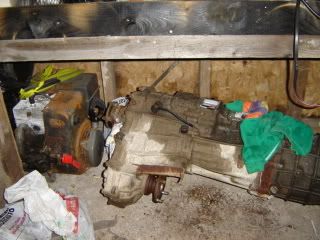
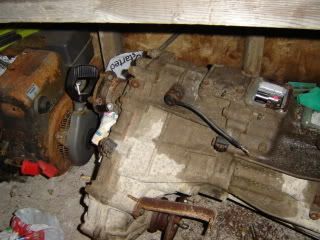
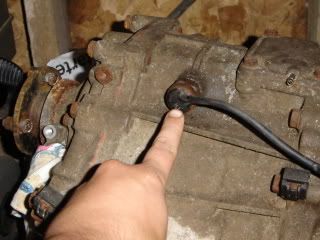
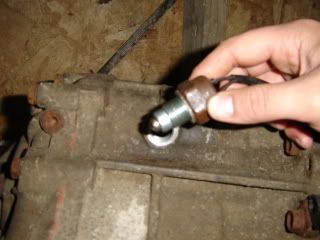
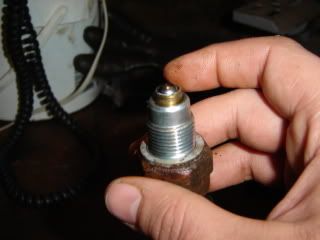
If I remember correctly there should be a connector on the end of the two wires, mine was riped off. Just a reminder this switch will be on the passenger side of your rig, above the front drive shaft output. Sorry the pics are small I only have dialup right now so I didn't want it to take all night to upload. Hope this helps. Keep us updated
Hope this helps. Keep us updated





If I remember correctly there should be a connector on the end of the two wires, mine was riped off. Just a reminder this switch will be on the passenger side of your rig, above the front drive shaft output. Sorry the pics are small I only have dialup right now so I didn't want it to take all night to upload.
 Hope this helps. Keep us updated
Hope this helps. Keep us updated
#12
Registered User
Thread Starter
Join Date: Nov 2006
Location: Charlotte, NC
Posts: 101
Likes: 0
Received 0 Likes
on
0 Posts
Here are those pics as promised:


If I remember correctly there should be a connector on the end of the two wires, mine was riped off. Just a reminder this switch will be on the passenger side of your rig, above the front drive shaft output. Sorry the pics are small I only have dialup right now so I didn't want it to take all night to upload. Hope this helps. Keep us updated
Hope this helps. Keep us updated



If I remember correctly there should be a connector on the end of the two wires, mine was riped off. Just a reminder this switch will be on the passenger side of your rig, above the front drive shaft output. Sorry the pics are small I only have dialup right now so I didn't want it to take all night to upload.
 Hope this helps. Keep us updated
Hope this helps. Keep us updated
I went out and took a look at my VSVs today and test the resistance across them. First, a pic:

I measured 52.2 ohms across the red (left) solenoid and 92.2 ohms across the blue (right) solenoid. According to the link on off-road.com, the VSVs should show 38-45 ohms. I'm thinking the blue solenoid is a bit high with the resistance. At least, it's a good place to start. Now, where can I find a blue solenoid to replace it? Is there a Toyota part number?
Related question: can I bypass the solenoids by directly connecting hoses 1&3 and 2&4 in the picture? Just to test that the ADD mechanism works? Nevermind, you answered my question above. So, I would just connect 1 to 3 and 2 to 4 and the 4WD should engage, correct? Assuming all the hoses are in good shape.
Last edited by intense; 08-05-2008 at 03:12 PM.
#14
Contributing Member
iTrader: (3)
Related question: can I bypass the solenoids by directly connecting hoses 1&3 and 2&4 in the picture? Just to test that the ADD mechanism works? Nevermind, you answered my question above. So, I would just connect 1 to 3 and 2 to 4 and the 4WD should engage, correct? Assuming all the hoses are in good shape.
#15
Registered User
I had a similar problem on my truck a few months ago. I took the solenoids out and tested them with a battery. They switched fine...everything else worked too. The last thing I noticed was that the vacuum canister wasn't holding vacuum. If you look in the passenger side front wheel well it is a small metal cylinder about 7-8" tall. On mine the nipple for one of the vacuum lines was rusted through. Braised on a new one and it has worked fine ever since.
Good luck,
Jason
Good luck,
Jason
#16
Registered User
Thread Starter
Join Date: Nov 2006
Location: Charlotte, NC
Posts: 101
Likes: 0
Received 0 Likes
on
0 Posts
Yes, as I posted earlier, VSVs can be bypassed for testing by connecting inlet line to outlet line (may need a vacuum line nipple to splice the hoses together if the outlet line is not long enough to reach the vacuum source). Also, test the VSV by applying power and feel for a click. That says that the internal parts are moving. If that is OK, try sucking or blowing air through the inlet/outlet path when the VSV is on and off. Should flow with power on and not flow with power off. If not, the internal passage may be clogged, try cleaning it out with some throttle body or electronics parts cleaner.
 ) I'm guessing I can just run power directly from the battery to the connector on the VSVs? Are they sensitive to polarity? Do both VSVs have to powered in order for the ADD to engage?
) I'm guessing I can just run power directly from the battery to the connector on the VSVs? Are they sensitive to polarity? Do both VSVs have to powered in order for the ADD to engage?I had a similar problem on my truck a few months ago. I took the solenoids out and tested them with a battery. They switched fine...everything else worked too. The last thing I noticed was that the vacuum canister wasn't holding vacuum. If you look in the passenger side front wheel well it is a small metal cylinder about 7-8" tall. On mine the nipple for one of the vacuum lines was rusted through. Braised on a new one and it has worked fine ever since.
Good luck,
Jason
Good luck,
Jason
Will report my findings tomorrow....
thanks all!!
#17
Registered User
Thread Starter
Join Date: Nov 2006
Location: Charlotte, NC
Posts: 101
Likes: 0
Received 0 Likes
on
0 Posts
Quick update:
just got done bypassing the VSVs. Before I connected the inlet hoses to the outlet hoses, I started the engine and felt for any vacuum. I could definitely feel a vacuum on both 'inlet' hoses. Although, one felt stronger than the other. For some strange reason.
Anyways, I connected the hoses and went for a drive. Didn't feel anything different. I had expected I would feel the front dif grinding on turns. Which is what I felt when the 4WD was working. I tried shifting the 4WD lever into 4hi and 4lo, but nothing felt different.
To test my conclusion, I put the 4Runner on jackstands and tested the 4WD again. I would have expected that I would see the front wheels moving. Regardless of the position of the 4WD lever. I'm still getting no movement out of the front wheels. And the 4WD light on the dash still isn't coming on.
I didn't get a chance to test the VSVs tonight. But I'm not sure they're the issue if I can't get 4WD to work when I bypass them.
Here's what I know so far:
4WD is not engaging.
4WD light on dish is not coming on
When I shift the 4WD lever, I can hear a clicking coming from behind the dash.
VSVs may or may not work. Both tested with some resistance. One at 50 ohms and the other near 100 ohms.
ADD, not tested
Center dif clunks when I shift into 4WD.
Bypassing VSVs, still no working 4WD.
To me, this indicates a bad ADD or bad vacuum line somewhere between the VSV and the ADD. What doesn't make sense to me is why the dash light isn't coming on. I would think it would even if I had a bad ADD or vacuum line. I don't see anything on the ADD to indicate it sends a signal to the dash light when 4WD is engaged.
just got done bypassing the VSVs. Before I connected the inlet hoses to the outlet hoses, I started the engine and felt for any vacuum. I could definitely feel a vacuum on both 'inlet' hoses. Although, one felt stronger than the other. For some strange reason.
Anyways, I connected the hoses and went for a drive. Didn't feel anything different. I had expected I would feel the front dif grinding on turns. Which is what I felt when the 4WD was working. I tried shifting the 4WD lever into 4hi and 4lo, but nothing felt different.
To test my conclusion, I put the 4Runner on jackstands and tested the 4WD again. I would have expected that I would see the front wheels moving. Regardless of the position of the 4WD lever. I'm still getting no movement out of the front wheels. And the 4WD light on the dash still isn't coming on.
I didn't get a chance to test the VSVs tonight. But I'm not sure they're the issue if I can't get 4WD to work when I bypass them.
Here's what I know so far:
4WD is not engaging.
4WD light on dish is not coming on
When I shift the 4WD lever, I can hear a clicking coming from behind the dash.
VSVs may or may not work. Both tested with some resistance. One at 50 ohms and the other near 100 ohms.
ADD, not tested
Center dif clunks when I shift into 4WD.
Bypassing VSVs, still no working 4WD.
To me, this indicates a bad ADD or bad vacuum line somewhere between the VSV and the ADD. What doesn't make sense to me is why the dash light isn't coming on. I would think it would even if I had a bad ADD or vacuum line. I don't see anything on the ADD to indicate it sends a signal to the dash light when 4WD is engaged.
#18
Contributing Member
iTrader: (3)
Read this page, it has all the troubleshooting steps you should need:
http://www.off-road.com/trucks4x4/ar....jsp?id=399612
For example, on the 4WD light:
"There are two switches that must be in the closed position for the 4WD light to come on. The first switch is controlled by the position of the transfer case shift lever. The second switch is on the ADD actuator and it turns on after the sleeve has moved into the right (locked) position. "
http://www.off-road.com/trucks4x4/ar....jsp?id=399612
For example, on the 4WD light:
"There are two switches that must be in the closed position for the 4WD light to come on. The first switch is controlled by the position of the transfer case shift lever. The second switch is on the ADD actuator and it turns on after the sleeve has moved into the right (locked) position. "
#19
Registered User
Quick update:
Here's what I know so far:
4WD is not engaging.
4WD light on dish is not coming on
When I shift the 4WD lever, I can hear a clicking coming from behind the dash.
VSVs may or may not work. Both tested with some resistance. One at 50 ohms and the other near 100 ohms.
ADD, not tested
Center dif clunks when I shift into 4WD.
Bypassing VSVs, still no working 4WD.
Here's what I know so far:
4WD is not engaging.
4WD light on dish is not coming on
When I shift the 4WD lever, I can hear a clicking coming from behind the dash.
VSVs may or may not work. Both tested with some resistance. One at 50 ohms and the other near 100 ohms.
ADD, not tested
Center dif clunks when I shift into 4WD.
Bypassing VSVs, still no working 4WD.
These are basically my exact symptoms. I removed the VSV's from the vehicle and tested them with a 9volt battery as outlined in the FSM. I think there is an online version of it on here. Then you know for sure. A small vacuum gauge helps to find leaks. Just start at the first connection and test the vacuum. Move your way along until you see a big drop. The problem should then be somewhere between those two points.
You can also bypass the vacuum canister by removing the vacuum lines from it and joining them temporarily. Once joined, start the truck and rev it up a little. There wont be enough vacuum to hold the actuator engaged at idle but if you give it some gas (putting it in gear and moving a few feet helped too) it should pull the actuator and turn the dash light on. I left my vacuum lines joined while I had new nipples braised on the canister. This way you can still have limited use of 4WD if you need it.
Good luck
Jason
Thread
Thread Starter
Forum
Replies
Last Post
smilen724
86-95 Trucks & 4Runners (Build-Up Section)
13
11-08-2015 04:11 PM









